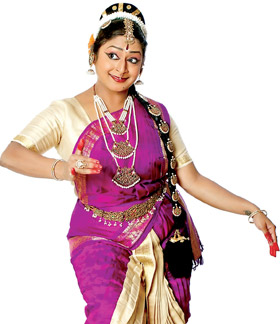Different gods, different images
Subashini Pathmanathan
Ananda Thandavam is the symbol of Bharatha Natyam. In Bharatha Natyam
a quite number of Thandava Karanas are very often adopted and interwoven
in-between the dances. There are altogether 108 Thandava Karanas in
Bharatha Natyam. Similarly even in Kuchipudi a variety of Lord Nataraja
images are adopted for dance. Bharatha Natyam, Kuchipudi and Odissi use
more poses of different gods which are based on Saivaism Sakthism and
Vishnavaism. Saivaism means that Lord Shiva is the main and foremost.
Meanwhile Sakthism consider Goddess Sakthi is the main God. But
Kathakali, Kathak, Manipuri and Mohini Attam are more or less based on
Vaishnava cult and Vaishnavaism. Vaishnavaism in Hinduism means that the
sect or the followers who believe and follow Lord Vishnu and his ten
incarnations are the supreme and main God. All the Indian dances are
deeply rooted in the Hinduism, Hindu culture and Hindu civilization.
 Among all the Indian classical dance forms, the classical dance form
of East Indian province of Orissa is Odissi. The word Orissa derived its
name from Orda Desa. Natyasastra of Bharata Muni is the basic source of
Indian and South East Asian dances. Like all the Indian classical dance
forms, Odissi dance form is also based on Natyasastra and Hindu
mythology. This is found in various sculptures, paintings and
inscriptions. The great Jain emperor Karavela was a great dancer and an
accompanist musician. Among all the Indian classical dance forms, the classical dance form
of East Indian province of Orissa is Odissi. The word Orissa derived its
name from Orda Desa. Natyasastra of Bharata Muni is the basic source of
Indian and South East Asian dances. Like all the Indian classical dance
forms, Odissi dance form is also based on Natyasastra and Hindu
mythology. This is found in various sculptures, paintings and
inscriptions. The great Jain emperor Karavela was a great dancer and an
accompanist musician.
Cultural survival
Due to his keen interest in dance and music, he himself arranged
numerous music and dance festivals. In the history of Orissa, due to
certain political changes and instability, the cultural survival and
customs of the State were invariably affected.
The 6th century A.D was a steady period for the cultural progress of
Orissa. During the 7th century, for the first time the dancing deity
lord Nataraja (Shiva) temple was built in Orissa. The image of lord
Nataraja found in Orissa differs from the image of lord Nataraja found
in South Indian States.
South Indian image of lord Nataraja is portrayed with four arms. But
in Orissa, different poses of lord Nataraj are depicted differently. The
total number of arms of lord Nataraj differs differently in different
places and temples. The total number of arms varies from two to ten.
This is evidenced by different Nataraj statues, temple paintings and
temple sculptures depicted differently all over Orissa.
Dancing poses
This could be seen in the famed Bhuvanesvar temple, Konarak temple
and Jaganath temple of Puri. These temples depict and portray a variety
of different avatars(incarnations ) of Lord Nataraj. Beside the dancing
poses of Lord Nataraj, dancing images of Lord Ganesha, and dancing
images of Lord Krishna are beautifully carved in the Jagannath temple
and various other shrines scattered all over the State of Orissa.
The famed Konarak temple which is described as citadel of oriental
architecture provides a wealth of feast for the eyes through the carved
dancing figures and musicians. Dance and music were developed in and
around the temples and environs.
Performing dance in the temple became a part of the temple rituals.
There are plenty of descriptive information in various inscriptions.
Though this tradition was discontinued in many of the temples, yet it
continued to flourish in the Jaganarth temple in Puri till recently.The
dancing girls of Orissa were known as Maharis like the devadasi of Tamil
Nadu. They enjoyed considerable status and honor in the society in the
early days. During the temple rituals persons were engaged to arrange
the services of Maharis systematically. Ray Ramananda, one of the
ministers of King Prataparudara was an outstanding exponent of Odissi
dance and music. He dedicated his life to spread the Vaishnava cult and
Vaishnava philosophy through fine arts.
Female dancers
After the period of Minister Ray Ramananda, the Vaishnava public
rejected the female dancers because of their malpractices of Maharis who
lost their reputation in society. Later males were encouraged to dance
in temples. These males dressed themselves as females and danced during
the temple rituals and festivals. The male dancers were called
Gothipuas.
They mainly danced for beautiful Vaishnava songs and lyrics. Despite
the ill reputation of Maharis they continued to perform in the temples
to some extent. |





